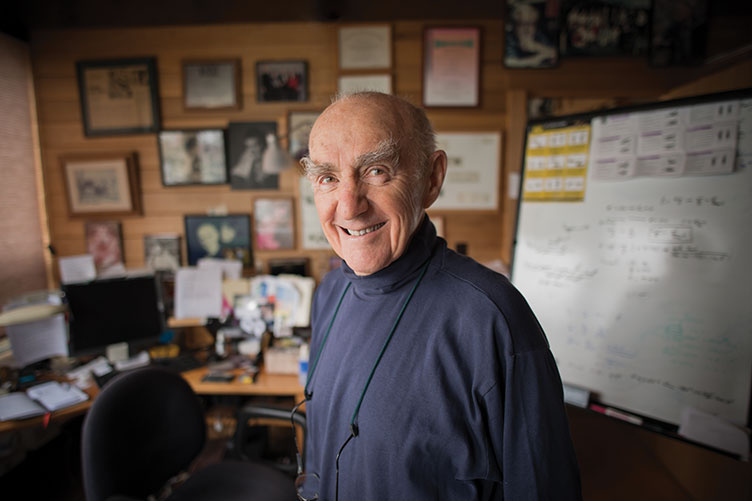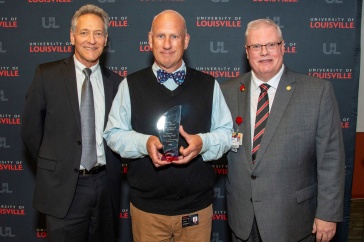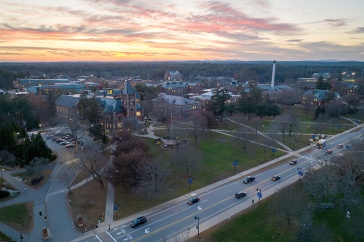
Photo by Michele Stapleton
Lee Grodzins ’46 has lived a full life. A nuclear physicist with both a PhD and an honorary ScD degree from Purdue University, Grodzins has participated in groundbreaking physics experiments, been named a Guggenheim Fellow twice and taught physics at Massachusetts Institute of Technology for almost 40 years. He is particularly proud of his accomplishments after age 60: securing 60 U.S. patents, starting (then selling) a company, and founding a nonprofit science education initiative.
“Curiosity and creativity don’t stop after a certain age. You decide you know certain things and you don’t want to change that thinking. But thinking outside the box really means thinking outside your box.”
“Curiosity and creativity don’t stop after a certain age,” Grodzins says, citing his own experience of using his knowledge of experimental nuclear physics to develop instruments that measure elemental distributions in the environment in the 1980s, some 30 years after his formal education ended. “You decide you know certain things and you don’t want to change that thinking. But thinking outside the box really means thinking outside your box.”
Born in Lowell, Massachusetts, his parents were Eastern European immigrants who settled in Manchester, New Hampshire. When he was in high school, Grodzins’ father died, leaving the family in debt. To support the family, Grodzins worked as a paperboy while his older sister, Ethel, worked as a sales clerk. Ethel was insistent that her brother attend college, so, at age 16, Grodzins enrolled at UNH, selling his paper route to help cover his tuition costs.
Taking advantage of the year-round curriculum UNH offered during World War II, Grodzins completed his degree in 2.5 years, graduating with a degree in mechanical engineering at the age of 18. He went to work at the General Electric Research Laboratory in Schenectady, New York, as an assistant in the nuclear physics group. “I had a ball,” he remembers. “I stayed in the lab 12 hours a day. They had to kick me out at night. ”
Grodzins earned his doctorate in 1954, and a year later joined noted physicist Maurice Goldhaber at Brookhaven National Laboratory on Long Island, studying the nuclei of atoms. With Goldhaber and physicist Andrew Sunyar, Grodzins performed a tabletop experiment that measured the helicity — the combination of spin and linear motion — of the neutrino that today remains a staple of the textbooks and curricula of nuclear physics.
One night, after a long day in the lab, Grodzins strolled around the dark Brookhaven campus and came upon a building that was still lit: the theater. Inside, one thespian in particular caught his eye: a young biologist named Lulu. “I joined the acting company,” Grodzins says, “and a year and a half later, Lulu and I were married. For the past 61 years, she has enriched and informed my life.”
Grodzins joined the physics faculty of MIT in 1959. In 1969, during the Vietnam War, he helped found the Union of Concerned Scientists, which today continues its fight for a healthier planet and a safer world. He also put his knowledge of physics to practical use, designing instruments to measure radon gas and, in the 1980s, establishing a company that designed and built environmental science equipment. He retired from MIT in 1998 to join that company, which was being run by his youngest son.
Grodzins’ latest endeavor is Cornerstones of Science (COS), a nonprofit organization he founded in 1999 at the Curtis Memorial Library in Brunswick, Maine, to connect children and adults to science and technology. COS provides public libraries with scientific resources such as loanable telescopes, traveling science trunks and training. Today, the company partners with 38 libraries in Maine, and many more in Arizona, Texas, Massachusetts and North Carolina.
Grodzins turned 91 in July. He is still curious, still enjoys being in the lab, still keeps up with his former students. “Many tell me how much my lifestyle has influenced them, which is gratifying,” he says. In return, he credits them with much of his professional success. “They’ve been a central part of my life. My biography would be grossly incomplete without them.”
Originally published in UNH Magazine Winter 2018 Issue
-
Written By:
Debbie Kane | Freelance Writer

















































